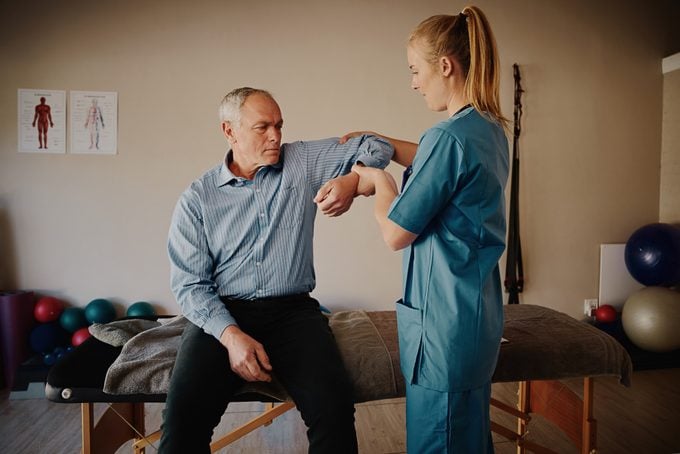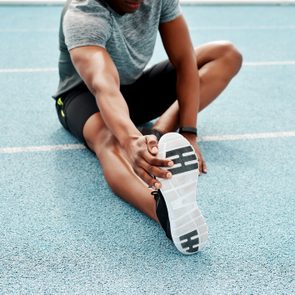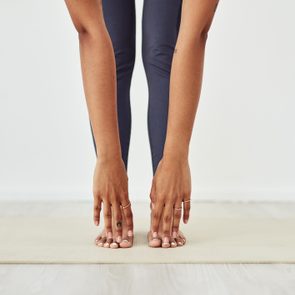What Range of Motion Is—and How to Increase It
Updated: Jul. 06, 2021
Do you groan or feel achy when you reach for something or sit down? Your range of motion may be in decline. Here's how to fix it.
Why your range of motion declines
As you get older, you might notice your shoulders, knees, and hips don’t move quite like they used to. Once upon a time, you could bring your knee to your chest. Now you’re lucky if you get it halfway there.
Or perhaps you’ve gotten injured, and you realize you’re not able to move the same way you could before.
These issues come down to your range of motion, something physical therapists, orthopedists, and even personal trainers address on a daily basis.
Here’s what you need to know about range of motion, plus some ways you can start to improve it.
What is range of motion?
Range of motion is how much and to what extent a joint moves, explains Michael Goldstein, a physical therapist at the Hospital for Special Surgery in New York City.
He says range of motion for any joint is determined by the limitations of the joint itself as well as the soft tissue structures around the joint, such as muscles and ligaments.
Sometimes people confuse flexibility with range of motion, or use the terms interchangeably. They’re related, but they’re not the same thing.
Flexibility refers specifically to the ability of muscle, tendon, and connective tissue to lengthen or elongate through a range of motion, according to Ryan Tibbetts, MD, an orthopedic surgeon at Texas Orthopedics in Austin.
Stretching and flexibility play an important role in improving range of motion.
Passive vs. active range of motion
There are two main types of range of motion: passive and active.
Most of the motions you make on a day-to-day basis are active, says Brian Schulz, MD, a sports medicine specialist and orthopedic surgeon at Cedars-Sinai Kerlan-Jobe Institute in Los Angeles.
“Passive motion is more common in a medical or training setting when a medical expert is examining a particular joint or treating someone,” he says. “For example, a trainer stretching an athlete.”
Active range of motion
Think of this as the movements you make.
“Active range of motion is when you use the muscles surrounding a joint to exclusively power movement of the joint,” explains Elizabeth C. Gardner, MD, an orthopedic surgeon at Yale Medicine, assistant professor at Yale School of Medicine, and head team orthopedic surgeon for Yale University Athletics.
An example of this would be a person actively raising their arm above their head.
Passive range of motion
Consider this assisted movement. Your body isn’t actively moving the muscles; you have help.
“Passive range of motion is when the power to move the joint comes exclusively from an external source, such as when a physical therapist moves a joint during treatment,” Dr. Gardner says.
In other words, if you let your arm go limp and someone else raises your arm above your head for you, that would be passive range of motion.
Active-assist range of motion
Though active and passive range of motion are the primary types, there’s also a third type known as active-assist range of motion.
“This is when the movement of the joint is partially powered by an external source and partly by the body’s own muscles,” Dr. Gardner notes.
For example, if you lift your arm and another person is guiding your arm up while applying some gentle force at the same time, that would be active-assist range of motion.
Another example: If you use a resistance strap to help you stretch your hamstrings, that is also active-assist range of motion.
Why you need to preserve your range
“Range of motion plays an important role in various functional tasks, including reaching overhead, negotiating stairs, and rising from low chairs,” explains Dr. Gardner.
Basically, when your range of motion becomes limited in joints you use frequently—like your hips, knees, shoulders, elbows, and so on—it’s harder to do everyday activities.
“Limitations can also cause compensatory movement patterns that put increased stress on other joints, which can lead to injury,” Dr. Gardner points out.
Even if your range of motion isn’t limited, it’s still worth knowing about, particularly if you’re an active person.
According to a 2020 review in Sage Open Medicine, performing strength training exercises at full range of motions versus partial range of motion produces better muscle- and strength-gain results, particularly in the lower body.
So touching your back knee to the ground during a lunge (full range of motion) will produce better results than doing lunges where you don’t go as deep (partial range of motion).

Causes of reduced range of motion
You know range of motion is important. But how do you get stuck with reduced range of motion? There are quite a few ways it can happen.
Aging
“As we age, we lose some elasticity in our soft tissue structures, which can contribute to decreased range of motion,” Dr. Goldstein says.
Reduced movement
“Lack of movement and poor postural positioning can cause you to lose range of motion,” Dr. Goldstein says. “In other words, if you don’t use it, you lose it.”
Injury and medical conditions
“Poor motion can result from an injury or wear and tear within the joint itself, such as arthritis or a tear in a ligament or tendon,” Dr. Gardner says.
Other medical conditions that can cause reduced range of motion include fractures (broken bones), muscular injuries, ankylosing spondylitis (an inflammatory spine disease), and skeletal abnormalities, according to Dr. Schulz.
Even minor shoulder injuries can lead to decrease range of motion, or even frozen shoulder, if the affected shoulder is not put through passive range of motion early after the injury.
Rheumatoid arthritis may also cause reduced range of motion in the affected joints, notes Krista Schofield, an occupational therapist and certified hand therapist at Providence Saint John’s Health Center’s Performance Therapy Center.
Areas affected by range of motion problems
Experts agree that the joints most commonly affected by reduced range of motion are those impacted by sitting: the joints in the neck, upper back, shoulders, hips, and low back.
“This is common due to adaptive posture that we develop from prolonged sitting at a computer or having our head flexed and looking down at our phones,” Dr. Goldstein says. “These postures can contribute to upper back tightness and poor ability to extend into an upright position. This can also impact your shoulder range of motion, limiting your ability to reach overhead or behind your back.”
Knees, elbows, wrists, and ankles may also be affected, but this is more likely to be the result of injury or a medical condition.
How to spot reduced range of motion
It’s worth noting there is a range of what’s “normal” for each joint. But, Dr. Schulz points out, there can be quite a bit of variability from person to person too.
That’s why, if you’re unsure about whether range of motion is an issue for you, it’s best to get checked out by a doctor or physical therapist.
Looking for a quicker answer? One way to check if a part of your body is experiencing reduced range of motion is to compare it with the other side.
“Joints should have symmetric range of motion,” Dr. Schulz says. “So the right knee and left knee should have similar ranges of motion.”
How to improve range of motion
There are a few key ways you can work to improve your range of motion on your own.
If you’re not seeing progress on your own or want personalized advice and exercises, getting the help of a professional, such as a physical therapist or orthopedic physician, is a good idea.
Stretch daily
“The best way to improve range of motion is with consistent stretching,” Dr. Gardner says. “If you think about how much time we spend sitting in chairs or on the couch, a daily effort is needed, ideally, to counteract this.”
Her advice: pick a consistent time during the day to stretch, like when you first get out of bed.
Stretches can be targeted to the area you specifically want to improve, so you might stretch your hips, shoulders, or neck.
Stay active in general
Active movement is key to bettering your range of motion, according to Dr. Goldstein.
“It’s important to follow stretching up with active motion to maintain the improvements made from a stretching exercise,” he explains.
For instance, you might stretch your rotator cuff muscles with a doorway stretch, then follow it up with an exercise that engages those muscles, such as a reverse fly with a resistance band or light dumbbells.
If you’re working on hip range of motion, you might stretch your hamstrings (for example, by touching your toes) and glutes (for example, doing a figure-four stretch), then perform squats.
Reduce stress
“Stress causes knots, tightness, and muscle tension,” Schofield says. It may be easier said than done, but doing what you can to keep stress at a minimum can help.
One potential strategy for destressing? Deep tissue massage, which can be a great follow-up to exercise and has some surprising benefits, according to Schofield.
















